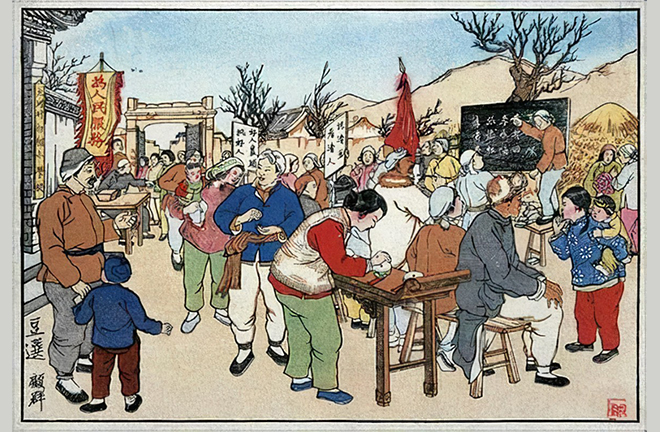Int’l scholars probe CPC’s governance experience

FILE PHOTO: A painting portraying bean voting, a form of general elections adopted by the CPC in the Shaanxi-Gansu-Ningxia Border Region in the 1940s
WUHAN—International experts shed light on the CPC’s governance experience at the Marxism and Socialism in the 21st Century Forum and the concurrent Global Academic Symposium on the Centennial Party and the Chinese Path on Nov. 20 and 21, virtually.
Over the past 100 years, in order to ensure the running of the country by the people, the CPC has led the Chinese people to carry out arduous explorations and gradually formed a complete system of people’s democracy. This consists of the system of people’s congresses, the system of Party-led multiparty cooperation and political consultation, the system of regional ethnic autonomy, and the system of community-level self-governance.
“Beans roll, beans vote, beans go to the right bowls.”
This popular folk rhyme vividly captured “bean voting,” a form of the general elections in the Shaanxi-Gansu-Ningxia Border Region in the 1940s.
In the 1940s, the CPC upheld democracy and liberty in the liberated areas. In order to mobilize illiterate farmers to vote in the election, the Party adopted various methods, among which the most popular one was “bean voting.”
Emerson Niou, a professor of political science at Duke University in the US, showed a New Year painting from 1946 at the forum. In the painting, a bowl is placed behind each of the five candidates, sitting on a bench, and a row of villagers is preparing to put the beans in their hands into the bowl behind the candidate they want to vote for. This painting is a vivid record of bean voting.
There were also popular pictorials, woodcuts, and other works of art at the time to describe bean voting. In some regions where anonymous voting was practiced, the villagers were required to put their hands in their sleeves. When throwing beans, they would touch each bowl to imitate the action of throwing beans, so that others could not tell which bowl the voter cast the bean into.
Democratic elections, consultations, decision-making, management, and oversight—Under the CPC’s leadership, this is how the people participate in practice and creation.
“The vitality of the whole-process people’s democracy in China comes from the democratic practices of the people, not the experiments of a few elites,” said Wang Xinsheng, vice president of Nankai University.
Unlike Western political parties, the CPC is the organizer of the Chinese revolution and also a great reformer. The CPC leads China’s social, economic, and political changes, leads the development of the knowledge field, and thinks about how to govern society and realize China’s modernization, said Spyros Themelis, an associate professor at the University of East Anglia in the UK.
How did the CPC achieve its great goals? What social, historical, economic and political factors enable the CPC to play such a role? Themelis believes that thinking about these two questions is very important for assessing the CPC’s contributions.
According to Olga Borokh, a leading research fellow from the Institute of Far Eastern Studies at the Russian Academy of Sciences, the Chinese path is different from the old Soviet model, and it is also different from that of the Western standard liberal economic model. The CPC’s exploration of China’s development path is based on China’s reality.
Martin Albrow, a fellow from the British Academy of Social Sciences, said that the world needs to apply the advantages of China’s governance system to global governance. China’s participation in global governance will help solve a series of global issues, including climate change and animal protection.
Edited by JIANG HONG
